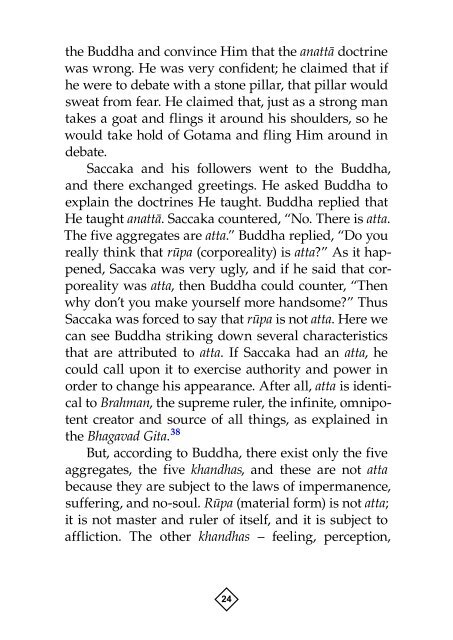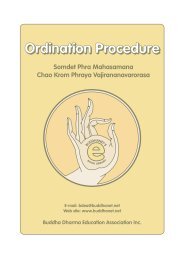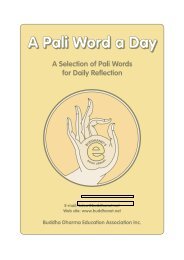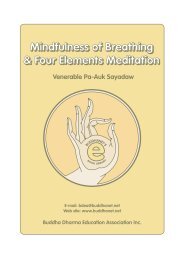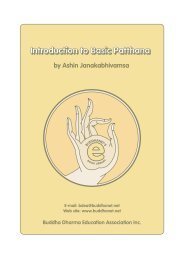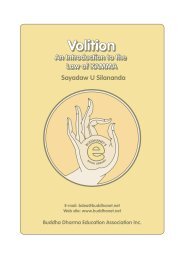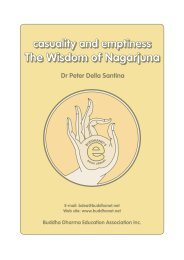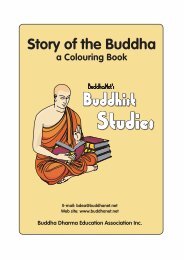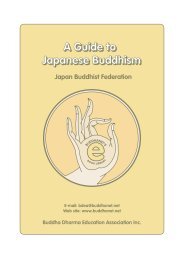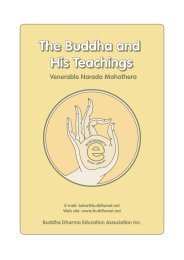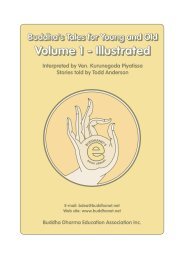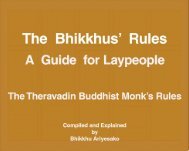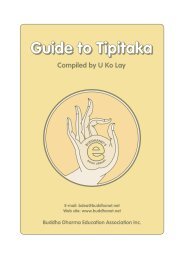No Inner Core: An Introduction to the Doctrine of Anatta - BuddhaNet
No Inner Core: An Introduction to the Doctrine of Anatta - BuddhaNet
No Inner Core: An Introduction to the Doctrine of Anatta - BuddhaNet
Create successful ePaper yourself
Turn your PDF publications into a flip-book with our unique Google optimized e-Paper software.
<strong>the</strong> Buddha and convince Him that <strong>the</strong> anattà doctrine<br />
was wrong. He was very confident; he claimed that if<br />
he were <strong>to</strong> debate with a s<strong>to</strong>ne pillar, that pillar would<br />
sweat from fear. He claimed that, just as a strong man<br />
takes a goat and flings it around his shoulders, so he<br />
would take hold <strong>of</strong> Gotama and fling Him around in<br />
debate.<br />
Saccaka and his followers went <strong>to</strong> <strong>the</strong> Buddha,<br />
and <strong>the</strong>re exchanged greetings. He asked Buddha <strong>to</strong><br />
explain <strong>the</strong> doctrines He taught. Buddha replied that<br />
He taught anattà. Saccaka countered, “<strong>No</strong>. There is atta.<br />
The five aggregates are atta.” Buddha replied, “Do you<br />
really think that råpa (corporeality) is atta?” As it happened,<br />
Saccaka was very ugly, and if he said that corporeality<br />
was atta, <strong>the</strong>n Buddha could counter, “Then<br />
why don’t you make yourself more handsome?” Thus<br />
Saccaka was forced <strong>to</strong> say that råpa is not atta. Here we<br />
can see Buddha striking down several characteristics<br />
that are attributed <strong>to</strong> atta. If Saccaka had an atta, he<br />
could call upon it <strong>to</strong> exercise authority and power in<br />
order <strong>to</strong> change his appearance. After all, atta is identical<br />
<strong>to</strong> Brahman, <strong>the</strong> supreme ruler, <strong>the</strong> infinite, omnipotent<br />
crea<strong>to</strong>r and source <strong>of</strong> all things, as explained in<br />
<strong>the</strong> Bhagavad Gita. 38<br />
But, according <strong>to</strong> Buddha, <strong>the</strong>re exist only <strong>the</strong> five<br />
aggregates, <strong>the</strong> five khandhas, and <strong>the</strong>se are not atta<br />
because <strong>the</strong>y are subject <strong>to</strong> <strong>the</strong> laws <strong>of</strong> impermanence,<br />
suffering, and no-soul. Råpa (material form) is not atta;<br />
it is not master and ruler <strong>of</strong> itself, and it is subject <strong>to</strong><br />
affliction. The o<strong>the</strong>r khandhas – feeling, perception,<br />
24


